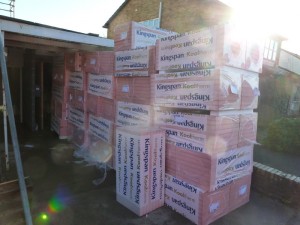The insulation arrived this week. This is the external wall insulation: all 300m² of it at once. We will start applying this in about week 23. In the meantime, we need to find somewhere for it! More on this to follow.
my fourwalls
1960s house extreme retro-fit and extension project


What size did you manage to get in the end? I was unable to find 100mm thickness easily of the K5 EWB. I was told however that it could be made to order if i waited for a batch run and put my order on another order.
We went for 120mm of K5, made up of 2 x 60mm layers. These will be stagger fixed and break bonded. In your case, for 100mm, I would recommend similar, i.e. 2 x 50mm. 50mm thickness is a standard size and Kingspan have loads of stock of this. However, no merchants seem to keep it on the ground, so you do need to order a pack as a minimum (6 sheets), and you need to wait about 2 weeks for it.
Also, 2 x thinner layers is easier in some ways than 1 x thicker layer. If your walls aren’t completely plumb, the thinner boards will have a bit of flex – not a chance with 100mm in one slab.
Im surprised to hear you say your preference for 2 boards in stead of one, my initial preference was for one single board. In my mind this was better for the insulative properties, as two boards would have lots of extra wall ties and therefor thermal bridging than with using just the one thick board.
I went to great lengths trying to find a supplier for the 100mm and so gave up my initial idea of 125mm, but now hearing you have gone for 120mm with two boards, perhaps i should change my mind!
two boards are also better as you can stagger them, thereby minimising air gaps between boards that you may have with one sheet. It is still the same amount of fixings for one or two layers – you use adhesive behind the first layer to bond to the masonry and then (as you can have both hands free with the first board stuck) you can mechanically fix the second all the way through your first board back to the masonry. No additional thermal bridges. Also, we are using nylon sleeved fixings to reduce bridging.